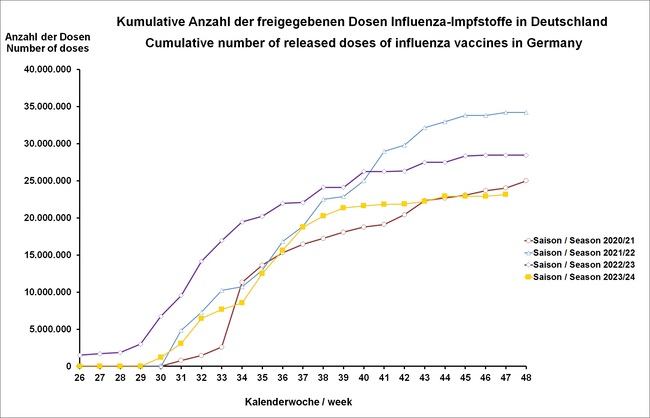Seasonal Influenza 2023/2024
Information on the vaccines approved in Germany, the approved vaccine doses and the vaccine base composition for the 2023/2024 season
Vaccines
The basic composition of the influenza vaccines has to be adapted to the current epidemiological situation every year because the properties of the circulating influenza viruses change. The exact composition is determined each year by the World Health Organization (WHO). This adjustment is checked for each vaccine in a procedure to change the approval. After approval of the strain adaptation, the Paul-Ehrlich-Institut tests and releases the manufactured influenza vaccines in batches, which can then be put on the market and used.
Released Vaccine Doses

 Stand/ as of: 26.11.2023 / 26 November 2023 (Quelle / Source: Paul-Ehrlich-Institut)
Stand/ as of: 26.11.2023 / 26 November 2023 (Quelle / Source: Paul-Ehrlich-Institut)
| Date | Calendar-
week | Number of Doses of Vaccines
(total Number) |
|---|
| 26 November 2023 | 47 | aprox. 23.1 Million |
| 19 November 2023 | 46 | aprox. 22.9 Million |
| 12 November 2023 | 45 | aprox. 22.9 Million |
| 5 November 2023 | 44 | aprox. 22.9 Million |
| 29 October 2023 | 43 | aprox. 22.2 Million |
| 22 October 2023 | 42 | aprox. 21.9 Million |
| 15 October 2023 | 41 | aprox. 21.8 Million |
| 8 October 2023 | 40 | aprox. 21.6 Million |
| 1 October 2023 | 39 | aprox. 21.3 Million |
| 24 September 2023 | 38 | aprox. 20.2 Million |
| 17 September 2023 | 37 | aprox. 18.8 Million |
| 10 September 2023 | 36 | aprox. 15.6 Million |
| 3 September 2023 | 35 | aprox. 12.5 Million |
| 27 August 2023 | 34 | aprox. 8.5 Million |
| 20 August 2023 | 33 | aprox. 7.7 Million |
| 13 August 2023 | 32 | aprox. 6.5 Million |
Composition of Influenza Virus Vaccines for the 2023/2024 Season
The influenza vaccine for the 2023/2024 season is composed of the antigens of globally circulating variants of viruses according to the recommendations of the WHO and the Committee for Medicinal Products for Human Use (CHMP) at the European Medicines Agency (EMA).
This composition differs from that of the 2022/2023 season.
Egg-based Vaccines
| WHO Recommendations* for the northern hemisphere | Suitable strains according to the recommendations of the EMA |
|---|
| A/Victoria/4897/2022 (H1N1)pdm09-like virus | - reassortant virus IVR-238, derived from A/Victoria/4897/2022
|
| A/Darwin/9/2021 (H3N2)-like virus | - reassortant virus IVR-227, derived from A/Darwin/6/2021
- reassortant virus IVR-228, derived from A/Darwin/9/2021
- reassortant virus SAN-010, derived from A/Darwin/9/2021
|
| B/Austria/1359417/2021 (B/Victoria lineage)-like virus | - B/Michigan/01/2021 (wild type)
- reassortant virus BVR-26, derived from B/Austria/1359417/2021
|
| B/Phuket/3073/2013 (B/Yamagata lineage)-like virus | - B/Phuket/3073/2013 (wild type)
- reassortant virus BVR-1B, derived from B/Phuket/3073/2013
|
Cell-based Vaccines
| WHO Recommendations* for the northern hemisphere | Suitable strains according to the recommendations of the EMA |
|---|
| A/Wisconsin/67/2022 (H1N1)pdm09-like virus | reassortant virus CVR-167, derived from A/Georgia/12/2022 |
| A/Darwin/6/2021 (H3N2)-like virus | A/Darwin/11/2021 (wild type) |
| B/Austria/1359417/2021 (B/Victoria lineage)-like virus | B/Singapore/WUH4618/2021 (wild type) |
| B/Phuket/3073/2013 (B/Yamagata lineage)-like virus | B/Singapore/INFTT-16-0610/2016 (wild type) |
Live attenuated Vaccines
| WHO Recommendations* for the northern hemisphere | Suitable strains according to the recommendations of the EMA |
|---|
| A/Victoria/4897/2022 (H1N1)pdm09-like virus | Virus MEDI 369815, derived from A/Norway/31694/2022 |
| A/Darwin/9/2021 (H3N2)-like virus | Virus MEDI 355293, derived from A/Norway/16606/2021 |
| B/Austria/1359417/2021 (B/Victoria lineage)-like virus | Virus MEDI 355292, derived from B/Austria/1359417/2021 |
| B/Phuket/3073/2013 (B/Yamagata lineage)-like virus | Virus MEDI 306444, derived from B/Phuket/3073/2013 |
* A and B denote the virus types, the place name refers to the place of virus isolation; the first digit indicates the number of the isolated strain, the second refers to the year of isolation. H and N are the two most important proteins in the virus envelope hemagglutinin and neuraminidase, the number behind them indicates the hemagglutinin and neuraminidase subtype.
top



